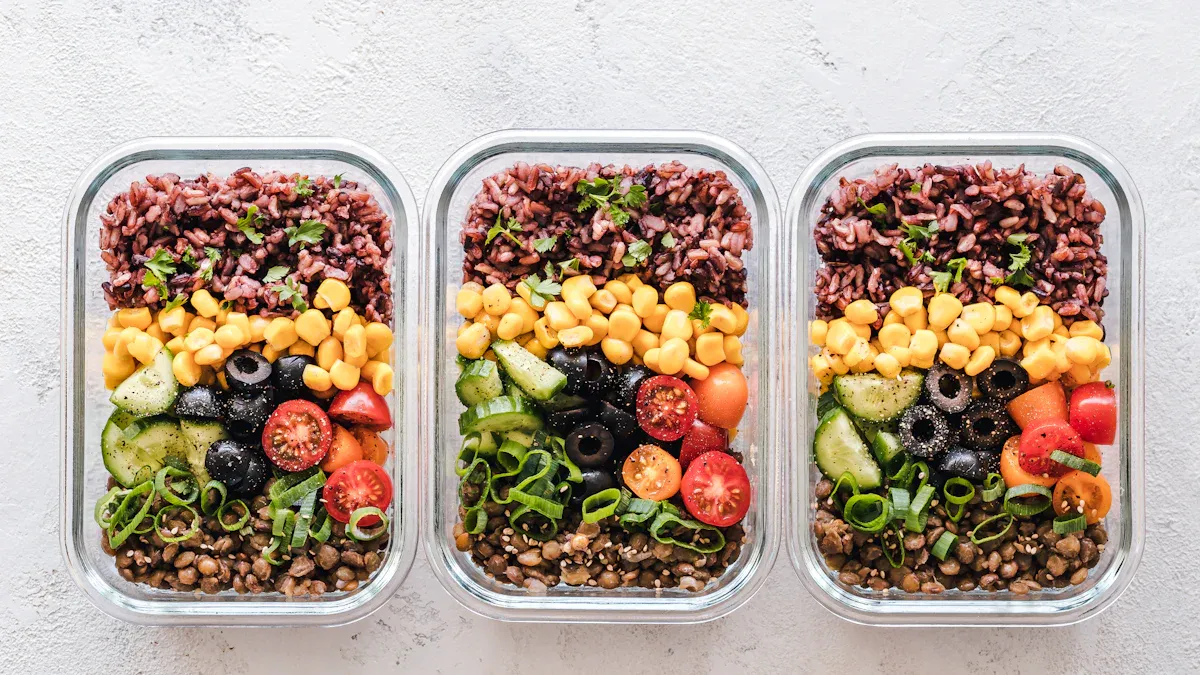How to Plan Nutritious Meals for Patients with Special Dietary Needs

Meal planning plays a vital role in supporting patients with special dietary needs. It ensures they receive the right nutrients while adhering to medical guidelines. As a caregiver, you take on a critical role in this process. You help plan meals, enhance food energy density, and adapt to dietary restrictions. This involvement has grown significantly, especially during transitions like hospital discharge.
Tailored meal plans improve health outcomes. For example:
App-designed plans better control sodium intake compared to participant-generated ones.
These plans adhere more closely to dietary preferences, with a TOPSIS score of 0.5227 versus 0.4564.
67% of users report positive satisfaction, with 33% saving time on meal planning.
By focusing on managing nutritional needs: meal planning for patients and caregivers, you can create balanced, personalized meal plans that promote health and well-being.
Key Takeaways
Planning meals is important for people with special diets. It helps them get the right nutrients and follow doctor’s advice.
Talk to healthcare experts to make custom meal plans. They know how to match meals to specific health needs.
Let patients help plan their meals. This makes them more likely to stick to the diet.
Try using meal planning apps to make it easier. These apps can track nutrients and create healthy meal ideas.
Use cheaper ingredient swaps to save money. This keeps meals tasty and affordable.
Managing Nutritional Needs: Meal Planning for Patients and Caregivers

Understanding Special Dietary Needs
Common medical conditions and their dietary implications
Certain medical conditions require specific dietary adjustments to improve health outcomes. For example, patients with diabetes benefit from low-glycemic foods to manage blood sugar levels. Those with hypertension need low-sodium diets to control blood pressure. Similarly, individuals with kidney disease must limit potassium and phosphorus intake. Understanding these dietary implications helps you create meal plans that align with medical recommendations.
Types of dietary restrictions and preferences
Dietary restrictions vary widely. Some patients follow gluten-free diets due to celiac disease, while others may need lactose-free options for dairy intolerance. Additionally, personal preferences, such as vegetarian or vegan diets, play a role in meal planning. By considering these factors, you can ensure meals are both nutritious and enjoyable.
Importance of individualized nutrition
Tailored nutrition plans improve patient outcomes significantly. A study showed that active patient involvement in meal planning increased energy intake and improved protein consumption. Healthcare providers also identified barriers and implemented solutions, leading to better patient experiences. Individualized plans address unique needs, ensuring optimal care and adherence.
Key Principles of Nutritious Meal Planning
Balance, variety, and portion control
Balanced meals include a mix of carbohydrates, proteins, and fats, along with essential vitamins and minerals. Portion control ensures you provide the right amount of nutrients without overloading calories. For example:
Half the plate should consist of vegetables.
A quarter should include lean protein.
The remaining quarter should feature whole grains.
This approach supports energy levels, weight management, and overall health.
Meeting macronutrient and micronutrient needs
Macronutrients like proteins, fats, and carbohydrates fuel the body, while micronutrients such as vitamins and minerals support immune function and prevent chronic diseases. Using tools like meal planning apps can help optimize nutrient intake. Research shows that app-designed plans improve sodium control and align better with dietary preferences compared to user-designed plans.
Adapting to dietary restrictions without compromising nutrition
Adapting meals to meet restrictions doesn’t mean sacrificing nutrition. For instance, you can replace wheat-based pasta with gluten-free alternatives or use almond milk instead of dairy. These substitutions maintain nutrient density while accommodating specific needs.
Tip: Experiment with different recipes to keep meals exciting and ensure patients receive a variety of nutrients.
Steps to Create a Tailored Meal Plan
Assessing Nutritional Needs
Consulting healthcare professionals
Start by consulting healthcare professionals, such as dietitians or nutritionists. They provide expert guidance on dietary requirements based on medical conditions. For example, they can recommend specific macronutrient ratios for patients with diabetes or suggest low-sodium options for those managing hypertension. This step ensures that meal plans align with health goals and medical advice.
Understanding medical history and preferences
Understanding a patient’s medical history and dietary preferences is essential. Use tools like structured questionnaires to gather information about allergies, food intolerances, and lifestyle habits. Keeping a food diary for a week can also help identify eating patterns and nutrient gaps. Studies show that food diaries improve the accuracy of dietary assessments, making it easier to create personalized meal plans.
Tip: Use Dietary Reference Intakes (DRIs) to ensure the meal plan meets micronutrient needs while accommodating restrictions like vegan or ketogenic diets.
Planning and Preparing Meals
Creating a weekly meal schedule
A structured weekly meal schedule simplifies meal planning. Begin by identifying calorie and macronutrient requirements using tools like the Basal Metabolic Rate (BMR) formula. Then, select a variety of foods from different groups—carbohydrates, proteins, fats, and fiber. Studies highlight that understanding individual dietary habits and preferences leads to more effective meal plans.
Incorporating variety and using portion control tools
Incorporate variety to keep meals interesting and nutritionally balanced. For example, rotate between lean proteins like chicken, fish, and tofu. Use portion control tools, such as measuring cups or food scales, to ensure accurate servings. This approach prevents overeating and helps maintain a balanced diet.
Callout: A well-structured meal plan improves adherence and supports health goals. Follow up regularly to adjust portions and food choices as needed.
Practical Implementation Tips
Preparing meals in advance
Meal prepping saves time and ensures consistency. Batch cooking and freezing meals for the week can reduce daily stress. For instance, prepare soups, stews, or casseroles in large quantities and store them in portioned containers. This method also helps manage nutritional needs effectively.
Involving patients in the planning process
Involve patients in meal planning to improve adherence. Discuss their preferences, cultural considerations, and taste preferences. Research shows that personalized plans addressing these factors enhance compliance and health outcomes. Patients who participate in planning are more likely to follow the meal plan and achieve their wellness goals.
Note: Customization is key. Adjust recipes to fit the patient’s lifestyle and educate them about healthy substitutes.
Overcoming Challenges in Meal Planning
Budget-Friendly Meal Planning
Affordable ingredient substitutions
You can reduce meal costs by making smart ingredient substitutions. Planning meals around sale items is an effective strategy. For example, if chicken is on sale, you can use it as the primary protein source for the week. In-season produce also offers affordable and fresh options. Swapping expensive ingredients for budget-friendly alternatives, like using lentils instead of ground beef, helps maintain meal quality without overspending. These small changes make a big difference in managing nutritional needs: meal planning for patients and caregivers becomes more sustainable and cost-effective.
Shopping tips for cost-effective meal prep
Shopping strategically can stretch your budget further. Start by creating a shopping list based on your weekly meal plan. Stick to the list to avoid impulse purchases. Buying in bulk, especially for staples like rice or beans, reduces costs over time. Visiting local farmers' markets often provides fresh produce at lower prices. Additionally, consider store-brand products, which usually offer the same quality as name brands but at a fraction of the cost.
Time-Saving Strategies
Batch cooking and freezing meals
Batch cooking simplifies meal preparation and saves time. Preparing meals in large quantities allows you to portion and freeze them for later use. This approach minimizes food waste and ensures you always have ready-to-eat options. Studies show that bulk buying and batch cooking not only save money but also reduce the temptation for last-minute takeout. By focusing on what you enjoy eating, batch cooking makes meal prep more flexible and enjoyable.
Using quick and easy recipes
Quick recipes streamline meal preparation. Choose dishes with minimal ingredients and short cooking times, such as stir-fries or one-pot meals. These recipes save time without compromising nutrition. For example, a vegetable stir-fry with tofu provides a balanced meal in under 20 minutes. Keeping a collection of simple recipes ensures you can prepare healthy meals even on busy days.
Addressing Patient Preferences
Balancing taste and nutrition
Balancing taste and nutrition improves dietary adherence. Patients often stick to meal plans when they find the food enjoyable. For instance, adding herbs and spices enhances flavor without adding extra calories. Research highlights that involving patients in their nutritional care increases energy intake and adherence to dietary recommendations. A structured meal plan with variety also helps overcome barriers like food monotony.
Encouraging patients to try new foods
Encouraging patients to explore new foods expands their palate and improves nutrition. Introduce one new ingredient or recipe each week. For example, quinoa can replace rice for added protein and fiber. This gradual approach makes the transition less overwhelming. Patients with oral health issues or altered taste preferences may need softer or milder foods. Tailoring meals to their needs ensures they feel comfortable trying new options.
Tip: Use creative presentation techniques, like colorful plating, to make meals more appealing and encourage patients to try unfamiliar foods.
Tools and Resources for Effective Meal Planning

Digital Tools and Apps
Meal planning apps and recipe databases
Digital tools simplify meal planning by offering personalized solutions. Apps like MyFitnessPal and Yummly provide access to extensive recipe databases tailored to dietary needs. These platforms allow you to filter recipes based on restrictions, such as gluten-free or low-sodium options. They also help you create weekly meal plans, saving time and effort.
Tip: Explore apps that sync with grocery lists to streamline shopping and reduce food waste.
Tools for tracking nutritional intake
Tracking tools enhance your ability to monitor nutrient intake and meet dietary goals. Many apps calculate macronutrient and micronutrient values based on age, gender, and activity level. In 2022, 1.4 billion people used diet and nutrition apps, with 76% reporting healthier eating habits. Users who tracked their food intake experienced 10% more weight loss compared to non-users. These tools not only improve adherence but also encourage positive behavior changes.
Professional and Community Support
Dietitians and nutritionists
Consulting dietitians ensures meal plans align with medical needs. A review of 26 studies involving 5,500 adults found that dietetic consultations significantly improved dietary behaviors and clinical outcomes, such as glycemic control and weight management. You can rely on these professionals to address complex dietary challenges and provide tailored advice.
Support groups and educational resources
Community support plays a vital role in meal planning. Joining support groups connects you with others facing similar challenges. These groups often share practical tips, recipes, and encouragement. Educational resources, such as workshops or online webinars, further enhance your knowledge and confidence in managing special diets.
Guides and References
Books and online guides for special diets
Books and online guides offer reliable information for planning meals. Recipe books address common barriers, like a lack of ideas, by providing diverse options. Platforms like Living Plate Rx allow you to access evidence-based meal plans and nutrition content, making it easier to stay on track.
Government and nonprofit resources
Government resources, such as the USDA food database, provide accurate nutritional information. Dietary Reference Intakes (DRIs) outline daily nutrient requirements, helping you create balanced meal plans. These tools ensure you meet essential dietary needs while adhering to restrictions.
Callout: Use trusted sources to guide your meal planning. Reliable information leads to better health outcomes and greater confidence in your choices.
Tailored meal planning plays a vital role in improving health outcomes for patients with special dietary needs. It ensures that meals align with medical requirements while respecting individual preferences. Consulting professionals, such as dietitians, enhances the effectiveness of these plans. Studies show that dietetic consultations improve dietary quality, diabetes management, and weight loss in over 5,500 adults.
Tip: Use tools like meal planning apps to simplify the process and track nutritional intake.
Take the first step today. Assess nutritional needs, create a plan, and involve patients in the process. Small changes lead to lasting health benefits.
FAQ
What should you do if a patient refuses to follow the meal plan?
Start by understanding their concerns. Discuss their preferences and adjust the plan to include foods they enjoy. Involve them in the planning process to increase engagement.
Tip: Offer small, gradual changes instead of drastic adjustments to improve adherence.
How can you ensure meals meet nutritional needs?
Use tools like meal planning apps or consult a dietitian. These resources help you track macronutrients and micronutrients. Include a variety of food groups in every meal to ensure balance.
Note: Refer to Dietary Reference Intakes (DRIs) for guidance on daily nutrient requirements.
What are some quick meal ideas for busy days?
Try simple recipes like vegetable stir-fries, one-pot meals, or salads with lean protein. Batch cooking and freezing meals also save time.
Example: A quinoa salad with grilled chicken and mixed vegetables provides a balanced, nutritious meal in under 20 minutes.
How do you handle food allergies or intolerances?
Identify the specific allergens and avoid them in meal preparation. Use safe substitutes like almond milk for dairy or gluten-free pasta for wheat. Always read food labels carefully.
Tip: Keep a list of safe alternatives to make substitutions easier during meal prep.
Can you plan nutritious meals on a tight budget?
Yes, focus on affordable staples like beans, rice, and seasonal produce. Buy in bulk and plan meals around sale items. Use leftovers creatively to reduce waste.
Callout: A well-planned shopping list helps you stick to your budget while meeting nutritional goals.
See Also
Recognizing Duodenal Cancer: Symptoms And Available Treatments
Gastrinoma Overview: Key Symptoms And Important Information
Choroid Plexus Carcinoma: Symptoms And Treatment Options Explained
